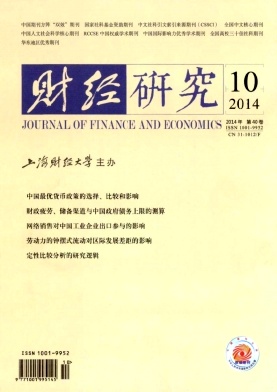定性比较分析的研究逻辑——兼论其对经济管理学研究的启示
财经研究 2014 年 第 40 卷第 10 期, 页码:97 - 107
摘要
参考文献
摘要
定性比较分析(Qualitative Comparative Analysis)正在西方社会科学研究领域悄然兴起。表面上看这只是一种研究社会科学的技术性手段,但实质上它代表着一种全新的研究逻辑,可以作为传统的定性研究和定量研究的重要补充。定性比较分析的基本逻辑是:基于布尔代数原理,通过讨论集合间的隶属关系发掘多个案例所展现的普遍特征。它与传统的定量研究相比主要有三个差异:(1)聚焦研究结果变量和自变量之间的非对称性关系,突破了传统定量研究基于相关系数的对称性思维局限;(2)认为达到同样的结果可以有多条路径,而每条路径都是不同的相关因素组合,这突破了传统定量研究拘泥于单一模型验证独立变量显著性的思维套路;(3)以模糊集合代替对变量的精确性测量,使研究结论更加符合真实世界的要求和客观规律。结合经济管理学等领域的具体案例,文章还阐述了定性比较分析缘何可以成为传统定性和定量研究以外的第三种研究思想,并提出了该方法的研究局限和在经济管理学领域的应用展望。
[1]陈向明.社会科学中的定性研究方法[J].中国社会科学,1996,(6):93-102.
[2]黄荣贵,桂勇.互联网与业主集体抗争:一项基于定性比较分析方法的研究[J].社会学研究,2009,(5):29-56.
[3]倪宁,杨玉红,基于模糊集定性比较分析方法改进胜任力建模[J].工业工程与管理,2009,(2):109-113.
[4]李健,西宝.管制俘获成因的定性比较分析[J].哈尔滨工程大学学报,2012,(7):923-928.
[5]袁治平,周再克,王为民.试论定性方法、定量方法的概念内涵及数学的应用[J].系统辩证学学报,2000,(4):56-59.
[6]Brady H E,Collier D.Rethinking social inquiry:Diverse tools,shared standards[M].Lanham,MD:Rowman and Littlefield,2004
[7]Cooper R G,Kleinschmidt E J.Winning businesses in product development:The critical success factors[J].Research Technology Management,1996,39(4):18-29.
[8]De Meur G,Rihoux B.L’analyse quali-quantitative comparée(AQQC-QCA):Approche,techniques et applications en sciences humaines[M].Louvain-la-Neuve:Academia-Bruylant,2002.
[9]Ebbinghaus B.When less is more:Selection problems in large-n and small-n cross-national comparisons[J].International Sociology,2005,20(2):133-152.
[10]Fischer C.What wealth-happiness paradox?A short note on the American case[J].Journal of Happiness Studies,2008,9(2):219-226.
[11]Fiss P C.A set-theoretic approach to organizational configurations[J].Academy of Management Review,2007,32(4):1180-1198.
[12]Gerring J.What is a case study and what is it good for?[J].American Political Science Review,2004,98(2):341-354.
[13]Gigerenzer G.From tools to theories:A heuristic of discovery in cognitive psychology[J].Psychological Review,1991,98(2):254-267.
[14]Greckhamer T,Misangyi V F,Elms H,et al.Using qualitative comparative analysis in strategic management research:An examination of combinations of industry,corporate,and business-unit effects[J].Organizational Research Methods,2008,11(2):695-726.
[15]Goertz G,Mahoney J.Two-Level theories and fuzzy-set analysis[J].Sociological Methods and Research,2005,33(4):497-538.
[16]Hagerty M R,Veenhoven R.Wealth and happiness revisited:Growing national income does go with greater happiness[J].Social Indicators Research,2003,64(1):1-27.
[17]Herrnstein R,Murray C.The bell curve:Intelligence and class structure in American life[M].New York:Free Press,1994.
[18]Luoma P.Social sustainability of community structures:A systematic comparative analysis within the oulu region in Northern Finland[A].Rihoux B,Grimm H.Innovative comparative methods for policy analysis[C].New York:Springer,2006.
[19]Mahoney J,Rueschemeyer D.Comparative historical analysis in the social sciences[M].Cambridge:Cambridge University Press,2003.
[20]Melamed T,Bozionelos N.Managerial promotion and height[J].Psychological Reports,1992,71:587-593.
[21]Misangyi V F,Elms H,Greckhamer T,et al.A new perspective on a fundamental debate:A multi level approach to industry,corporate,and business-unit effects[J].Strategic Management Journal,2006,27(6):571-590.
[22]Moses J,Rihoux B,Kittel B.Mapping political methodology:Reflections on a European perspective[J].European Political Science,2005,4(1):55-68.
[23]Ragin C.The comparative method:Moving beyond qualitative and quantitative strategies[M].Berkeley:University of California Press,1989.
[24]Ragin C.Redesigning social inquiry:Fuzzy sets and beyond[M].Chicago:University of Chicago Press,2008.
[25]Ragin C,Becker H.What is a case?:Exploring the foundations of social inquiry[M].Cambridge:Cambridge University Press,1992.
[26]Ragin C,Rihoux B.Qualitative comparative analysis(QCA):State of the art and prospects[J].Qualitative Methods,2004,2(2):3-13.
[27]Rihoux B.Qualitative comparative analysis(QCA)and related systematic comparative methods[J].International Sociology,2006,21(5):679-706.
[28]Rihoux B.Bridging the gap between the qualitative and quantitative worlds?:A retrospective and prospective view on qualitative comparative analysis[J].Field Methods,2003,15(4):351-365.
[29]Rihoux B,De Meur G,Yamasaki S,Ronsse S.Ce n’est qu’un début,continuons le...débat.Un agenda pour la recherché[J].Revue Internationale de Politique Comparée,2004,11(1):145-153.
[30]Sager F.Metropolitan institutions and policy coordination:The integration of land use and transport policies in Swiss urban areas[J].Governance,2004,18(2):227-256.
[31]Schneider C Q,Wagemann C.Reducing complexity in qualitative comparative analysis(QCA):Remote and proximate factors and the consolidation of democracy[J].European Journal of Political Research2006,45(5):751-786.
[32]Schneider C Q,Wagemann C.Standards of good practice in qualitative comparative analysis(QCA)and fuzzy-sets[J].Comparative Sociology,2010,9(3):397-418.
[33]Sprinz D F,Nahmias-Wolinsky Y.Models,numbers and cases:Methods for studying international relations[M].Ann Arbor:University of Michigan Press,2004.
[34]Tashakkori A,Teddlie C.Handbook of mixed methods in the social and behavioral research[M].Thousand Oaks,CA:Sage,2003.
[35]Woodside A.Case study research:Theory,methods and practice[M].Bingley:Emerald Group Publishing,2010.
[36]Woodside A.Moving beyond multiple regression analysis to algorithms:Calling for adoption of a paradigm shift from symmetric to asymmetric thinking in data analysis and crafting theory[J].Journal of Business Research,2013,66(4):463-472.
[37]Woodside A,Schpektor A,Xia X.Triple sense-making of findings from marketing experiments using the dominant variable based-logic,case-based logic,and isomorphic modeling[J].International Journal of Business and Economics,2013,12(2):131-153.
[38]Zadeh L A.Fuzzy sets[J].Information and Control,1965,8(3):338-353.
[2]黄荣贵,桂勇.互联网与业主集体抗争:一项基于定性比较分析方法的研究[J].社会学研究,2009,(5):29-56.
[3]倪宁,杨玉红,基于模糊集定性比较分析方法改进胜任力建模[J].工业工程与管理,2009,(2):109-113.
[4]李健,西宝.管制俘获成因的定性比较分析[J].哈尔滨工程大学学报,2012,(7):923-928.
[5]袁治平,周再克,王为民.试论定性方法、定量方法的概念内涵及数学的应用[J].系统辩证学学报,2000,(4):56-59.
[6]Brady H E,Collier D.Rethinking social inquiry:Diverse tools,shared standards[M].Lanham,MD:Rowman and Littlefield,2004
[7]Cooper R G,Kleinschmidt E J.Winning businesses in product development:The critical success factors[J].Research Technology Management,1996,39(4):18-29.
[8]De Meur G,Rihoux B.L’analyse quali-quantitative comparée(AQQC-QCA):Approche,techniques et applications en sciences humaines[M].Louvain-la-Neuve:Academia-Bruylant,2002.
[9]Ebbinghaus B.When less is more:Selection problems in large-n and small-n cross-national comparisons[J].International Sociology,2005,20(2):133-152.
[10]Fischer C.What wealth-happiness paradox?A short note on the American case[J].Journal of Happiness Studies,2008,9(2):219-226.
[11]Fiss P C.A set-theoretic approach to organizational configurations[J].Academy of Management Review,2007,32(4):1180-1198.
[12]Gerring J.What is a case study and what is it good for?[J].American Political Science Review,2004,98(2):341-354.
[13]Gigerenzer G.From tools to theories:A heuristic of discovery in cognitive psychology[J].Psychological Review,1991,98(2):254-267.
[14]Greckhamer T,Misangyi V F,Elms H,et al.Using qualitative comparative analysis in strategic management research:An examination of combinations of industry,corporate,and business-unit effects[J].Organizational Research Methods,2008,11(2):695-726.
[15]Goertz G,Mahoney J.Two-Level theories and fuzzy-set analysis[J].Sociological Methods and Research,2005,33(4):497-538.
[16]Hagerty M R,Veenhoven R.Wealth and happiness revisited:Growing national income does go with greater happiness[J].Social Indicators Research,2003,64(1):1-27.
[17]Herrnstein R,Murray C.The bell curve:Intelligence and class structure in American life[M].New York:Free Press,1994.
[18]Luoma P.Social sustainability of community structures:A systematic comparative analysis within the oulu region in Northern Finland[A].Rihoux B,Grimm H.Innovative comparative methods for policy analysis[C].New York:Springer,2006.
[19]Mahoney J,Rueschemeyer D.Comparative historical analysis in the social sciences[M].Cambridge:Cambridge University Press,2003.
[20]Melamed T,Bozionelos N.Managerial promotion and height[J].Psychological Reports,1992,71:587-593.
[21]Misangyi V F,Elms H,Greckhamer T,et al.A new perspective on a fundamental debate:A multi level approach to industry,corporate,and business-unit effects[J].Strategic Management Journal,2006,27(6):571-590.
[22]Moses J,Rihoux B,Kittel B.Mapping political methodology:Reflections on a European perspective[J].European Political Science,2005,4(1):55-68.
[23]Ragin C.The comparative method:Moving beyond qualitative and quantitative strategies[M].Berkeley:University of California Press,1989.
[24]Ragin C.Redesigning social inquiry:Fuzzy sets and beyond[M].Chicago:University of Chicago Press,2008.
[25]Ragin C,Becker H.What is a case?:Exploring the foundations of social inquiry[M].Cambridge:Cambridge University Press,1992.
[26]Ragin C,Rihoux B.Qualitative comparative analysis(QCA):State of the art and prospects[J].Qualitative Methods,2004,2(2):3-13.
[27]Rihoux B.Qualitative comparative analysis(QCA)and related systematic comparative methods[J].International Sociology,2006,21(5):679-706.
[28]Rihoux B.Bridging the gap between the qualitative and quantitative worlds?:A retrospective and prospective view on qualitative comparative analysis[J].Field Methods,2003,15(4):351-365.
[29]Rihoux B,De Meur G,Yamasaki S,Ronsse S.Ce n’est qu’un début,continuons le...débat.Un agenda pour la recherché[J].Revue Internationale de Politique Comparée,2004,11(1):145-153.
[30]Sager F.Metropolitan institutions and policy coordination:The integration of land use and transport policies in Swiss urban areas[J].Governance,2004,18(2):227-256.
[31]Schneider C Q,Wagemann C.Reducing complexity in qualitative comparative analysis(QCA):Remote and proximate factors and the consolidation of democracy[J].European Journal of Political Research2006,45(5):751-786.
[32]Schneider C Q,Wagemann C.Standards of good practice in qualitative comparative analysis(QCA)and fuzzy-sets[J].Comparative Sociology,2010,9(3):397-418.
[33]Sprinz D F,Nahmias-Wolinsky Y.Models,numbers and cases:Methods for studying international relations[M].Ann Arbor:University of Michigan Press,2004.
[34]Tashakkori A,Teddlie C.Handbook of mixed methods in the social and behavioral research[M].Thousand Oaks,CA:Sage,2003.
[35]Woodside A.Case study research:Theory,methods and practice[M].Bingley:Emerald Group Publishing,2010.
[36]Woodside A.Moving beyond multiple regression analysis to algorithms:Calling for adoption of a paradigm shift from symmetric to asymmetric thinking in data analysis and crafting theory[J].Journal of Business Research,2013,66(4):463-472.
[37]Woodside A,Schpektor A,Xia X.Triple sense-making of findings from marketing experiments using the dominant variable based-logic,case-based logic,and isomorphic modeling[J].International Journal of Business and Economics,2013,12(2):131-153.
[38]Zadeh L A.Fuzzy sets[J].Information and Control,1965,8(3):338-353.
引用本文
夏鑫, 何建民, 刘嘉毅. 定性比较分析的研究逻辑——兼论其对经济管理学研究的启示[J]. 财经研究, 2014, 40(10): 97–107.
导出参考文献,格式为:





 9658
9658  4746
4746

